Optimizing H-BIM Workflow for Interventions on Historical Building Elements
Abstract
:1. Introduction
1.1. Heritage Buildings Interventions
- International Charter for the Conservation and Restoration of Monuments and Sites (The Venice Charter) (1964) [6];
- Athens Charter for the Restoration of Historic Monuments (1931) [7];
- Washington Charter for the Conservation of Historic Towns and Urban Areas (1987) [8];
- The Charter on the Built Vernacular Heritage (1999) [9];
- The Charter of Krakow—Principles for Conservation and Restoration of Built Heritage (2000) [10];
- ICOMOS Charter—Principles for the Analysis, Conservation and Structural Restoration of Architectural Heritage (2003) [11];
- The Burra Charter: The Australia ICOMOS Charter for the Conservation of Places of Cultural Significance (2013) [12].
1.2. Objective of the Paper
2. Related Work
2.1. Ontologies for the Construction Domain
2.2. Ontologies for Heritage Buildings
2.3. Heritage Building Information Modelling and Semantic Technologies
3. Workflow for H-BIM and Semantic Model
3.1. H-BIM
3.2. Semantic Modelling
4. Results
- 1.
- Who is responsible for the restoration of the mascaron?
- 2.
- What is the height of the main door of the building?
5. Discussion
6. Conclusions and Future Developments
Author Contributions
Funding
Institutional Review Board Statement
Informed Consent Statement
Data Availability Statement
Acknowledgments
Conflicts of Interest
References
- Hofweber, T. “Logic and Ontology”. The Stanford Encyclopedia of Philosophy (Spring 2021 Edition). Zalta, E.N., Ed.; Available online: https://plato.stanford.edu/archives/spr2021/entries/logic-ontology/ (accessed on 13 July 2022).
- Gruber, T.R. A translation approach to portable ontologies. Knowl. Acquis. 1993, 5, 199–220. [Google Scholar] [CrossRef]
- Chandrasekaran, B.; Josephson, J.R.; Benjamins, V.R. What are ontologies, and why do we need them? IEEE Intell. Syst. Appl. 1999, 14, 20–26. [Google Scholar] [CrossRef] [Green Version]
- Hagedorn, T.J.; Smith, B.; Krishnamurty, S.; Grosse, I. Interoperability of disparate engineering domain ontologies using basic formal ontology. J. Eng. Des. 2019, 30, 625–654. [Google Scholar] [CrossRef] [Green Version]
- Tibaut, A.; Guerra de Oliveira, S. A Framework for the Evaluation of the Cultural Heritage Information Ontology. Appl. Sci. 2020, 12, 795. [Google Scholar] [CrossRef]
- Bonelli, R. La ‘carta di Venezia’ per il Restauro Architettonico; Italia Nostra: Rome, Italy, 1964; pp. 1–6. [Google Scholar]
- Congress Internationaux d’Architecture moderne (CIAM). La Charte d’Athenes or the Athens Charter 1933; Tyrwhitt, T.J., Ed.; The Library of the Graduate School of Design, Harvard University: Paris, France, 1946. [Google Scholar]
- ICOMOS. Charter for the Conservation of Historic Towns and Urban Areas; ICOMOS General Assembly: Washington, DC, USA, 1987. [Google Scholar]
- ICOMOS. Charter on the Built Vernacular Heritage; ICOMOS: Paris, France, 1999. [Google Scholar]
- ICOMOS. The Charter of Krakow–Principles for Conservation and Restoration of Built Heritage; ICOMOS: Krakow, Poland, 2000. [Google Scholar]
- ICOMOS/ISCARSAH Committee. ICOMOS Charter—Principles for the analysis, conservation and structural restoration of architectural heritage. In Proceedings of the ICOMOS 14th General Assembly and Scientific Symposium, Victoria Falls, Zimbabwe, Africa, 27–31 October 2003; Volume 2731. [Google Scholar]
- ICOMOS. The Burra Charter: The Australia ICOMOS Charter for Places of Cultural Significance; ICOMOS: Paris, France, 2013. [Google Scholar]
- Getty Research Institute (2017)–Art & Architecture Thesaurus ®. Available online: https://www.getty.edu/research/tools/vocabularies/aat/ (accessed on 13 July 2022).
- Zhong, B.; Wu, H.; Li, H.; Sepasgozar, S.; Luo, H.; He, L. A scientometric analysis and critical review of construction related ontology research. Autom. Constr. 2019, 101, 17–31. [Google Scholar] [CrossRef]
- Mohammadi, S.; Tavakolan, M.; Zahraie, B. An intelligent simulation-based framework for automated planning of concrete construction works. Eng. Constr. Archit. Manag. 2022, 29, 916–939. [Google Scholar] [CrossRef]
- Guven, G.; Arceo, A.; Bennett, A.; Tham, M.; Olanrewaju, B.; McGrail, M.; Isin, K.; Olson, A.W.; Saxe, S. A construction classification system database for understanding resource use in building construction. Sci. Data 2022, 9, 42. [Google Scholar] [CrossRef]
- Wu, C.; Wu, P.; Wang, J.; Jiang, R.; Chen, M.; Wang, X. Ontological knowledge base for concrete bridge rehabilitation project management. Autom. Constr. 2021, 121, 103428. [Google Scholar] [CrossRef]
- Zheng, Y.; Törmä, S.; Seppänen, O. A shared ontology suite for digital construction workflow. Autom. Constr. 2021, 132, 103930. [Google Scholar] [CrossRef]
- Corry, E.; Pauwels, P.; Hu, S.; Keane, M.; O’Donnell, J. A performance assessment ontology for the environmental and energy management of buildings. Autom. Constr. 2015, 57, 249–259. [Google Scholar] [CrossRef] [Green Version]
- Amorocho, J.A.P.; Hartmann, T. Reno-Inst: An ontology to support renovation projects planning and renovation products installation. Adv. Eng. Inform. 2021, 50, 101415. [Google Scholar] [CrossRef]
- Hernández, F.; Rodrigo, L.; Contreras, J.; Carbone, F.; Fundación, F.C.; Botín, M. Building a Cultural Heritage Ontology for Cantabria. In Proceedings of the Annual Conference of CIDOC, Athens, Greece, 15–18 September 2008; pp. 1–14. [Google Scholar]
- Patino, O.P.Z.; Van Orshoven, J.; Steenberghen, T. Merging and expanding existing ontologies to cover the Built Cultural Heritage domain. J. Cult. Herit. Manag. Sustain. Dev. 2018, 8, 162–178. [Google Scholar] [CrossRef]
- Messaoudi, T.; Véron, P.; Halin, G.; De Luca, L. An ontological model for the reality-based 3D annotation of heritage building conservation state. J. Cult. Herit. 2018, 29, 100–112. [Google Scholar] [CrossRef] [Green Version]
- Acierno, M.; Cursi, S.; Simeone, D.; Fiorani, D. Architectural heritage knowledge modelling: An ontology-based framework for conservation process. J. Cult. Herit. 2017, 24, 124–133. [Google Scholar] [CrossRef]
- Erlangen CRM/OWL–An OWL DL 1.0 Implementation of the CIDOC Conceptual Reference Model (CIDOC CRM). Available online: https://erlangen-crm.org/current-version (accessed on 13 July 2022).
- Quattrini, R.; Pierdicca, R.; Morbidoni, C. Knowledge-based data enrichment for HBIM: Exploring high-quality models using the semantic-web. J. Cult. Herit. 2017, 28, 129–139. [Google Scholar] [CrossRef]
- Yang, X.; Grussenmeyer, P.; Koehl, M.; Macher, H.; Murtiyoso, A.; Landes, T. Review of built heritage modelling: Integration of HBIM and other information techniques. J. Cult. Herit. 2020, 46, 350–360. [Google Scholar] [CrossRef]
- Bruno, S.; De Fino, M.; Fatiguso, F. Historic Building Information Modelling: Performance assessment for diagnosis-aided information modelling and management. Autom. Constr. 2018, 86, 256–276. [Google Scholar] [CrossRef]
- Mohamed, A.G.; Abdallah, M.R.; Marzouk, M. BIM and semantic web-based maintenance information for existing buildings. Autom. Constr. 2020, 116, 103209. [Google Scholar] [CrossRef]
- Colucci, E.; Xing, X.; Kokla, M.; Mostafavi, M.A.; Noardo, F.; Spanò, A. Ontology-based semantic conceptualisation of historical built heritage to generate parametric structured models from point clouds. Appl. Sci. 2021, 11, 2813. [Google Scholar] [CrossRef]
- Antonopoulou, S.; Bryan, P. BIM for Heritage: Developing A Historic Building Information Model; Historic England: Swindon, UK, 2017. [Google Scholar]
- Scianna, A.; Gaglio, G.F.; La Guardia, M. HBIM data management in historical and archaeological buildings. Archeol. E Calc. 2020, 31, 231–252. [Google Scholar]
- Nieto-Julián, J.E.; Antón, D.; Moyano, J.J. Implementation and management of structural deformations into historic building information models. Int. J. Archit. Herit. 2020, 14, 1384–1397. [Google Scholar] [CrossRef]
- León-Robles, C.A.; Reinoso-Gordo, J.F.; González-Quiñones, J.J. Heritage building information modeling (H-BIM) applied to a stone bridge. ISPRS Int. J. Geo-Inf. 2019, 8, 121. [Google Scholar] [CrossRef] [Green Version]
- Cursi, S.; Martinelli, L.; Paraciani, N.; Calcerano, F.; Gigliarelli, E. Linking external knowledge to heritage BIM. Autom. Constr. 2022, 141, 104444. [Google Scholar] [CrossRef]
- Industry Foundation Classes (IFC)–BuildingSMART International. Available online: https://www.buildingsmart.org/standards/bsi-standards/industry-foundation-classes/ (accessed on 20 April 2022).
- ifcOWL Ontology (IFC4_ADD2_TC1). Available online: https://standards.buildingsmart.org/IFC/DEV/IFC4/ADD2_TC1/OWL/index.html (accessed on 13 July 2022).
- Pauwels, P.; Terkaj, W. EXPRESS to OWL for construction industry: Towards a recommendable and usable ifcOWL ontology. Autom. Constr. 2016, 63, 100–133. [Google Scholar] [CrossRef]
- Terkaj, W.; Pauwels, P. A method to generate a modular ifcOWL ontology. In Proceedings of the 8th International Workshop on Formal Ontologies meet Industry, Bolzano-Bozen, Italy, 21 September 2017; Volume 2050. [Google Scholar]
- Sacks, R.; Eastman, C.; Lee, G.; Teicholz, P. BIM Handbook: A Guide to Building Information Modeling for Owners, Designers, Engineers, Contractors, and Facility Managers; John Wiley & Sons: Hoboken, NJ, USA, 2018. [Google Scholar]
- Duque-Ramos, A.; Fernández-Breis, J.T.; Stevens, R.; Aussenac-Gilles, N. OQuaRE: A SQuaRE-based approach for evaluating the quality of ontologies. J. Res. Pract. Inf. Technol. 2011, 43, 159–176. [Google Scholar]
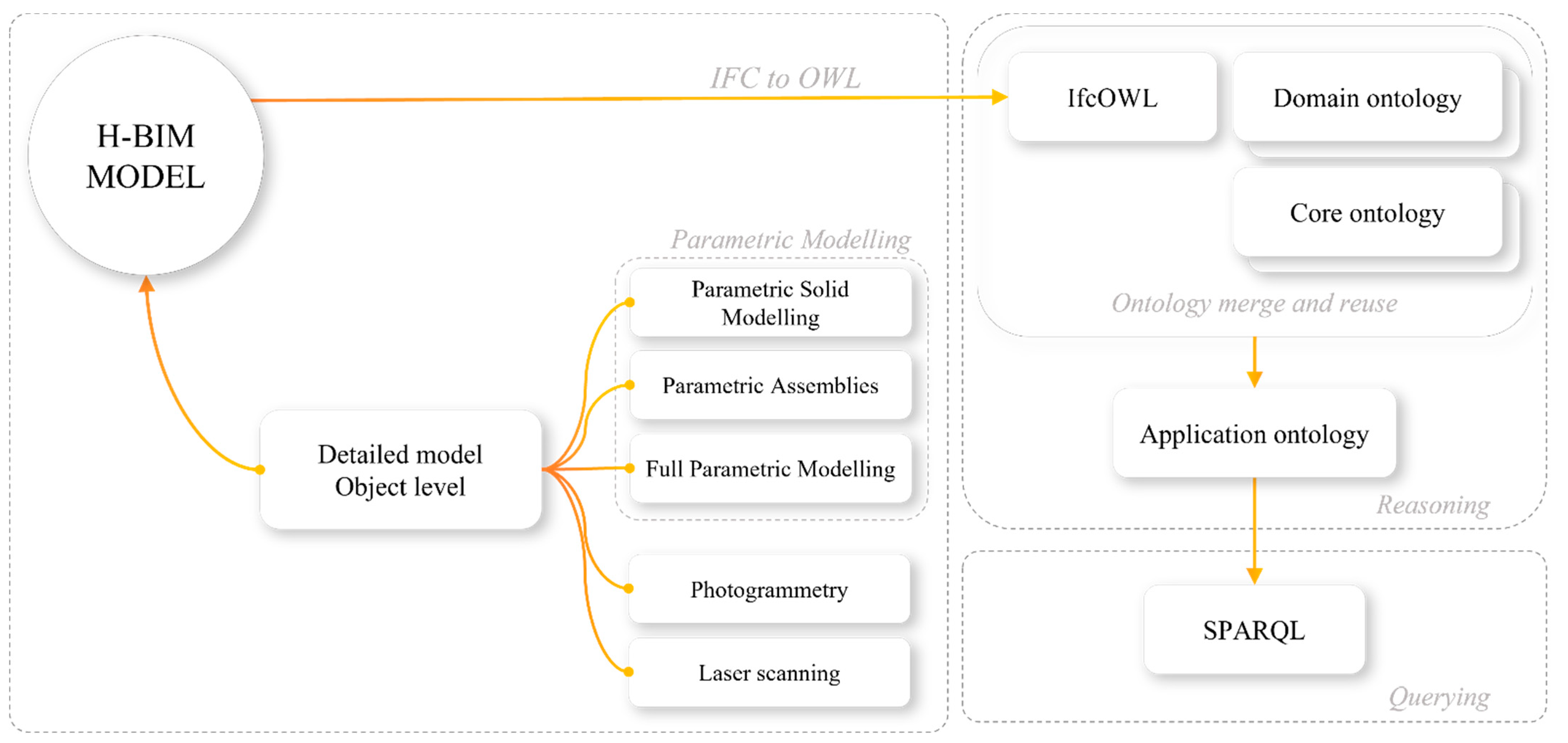
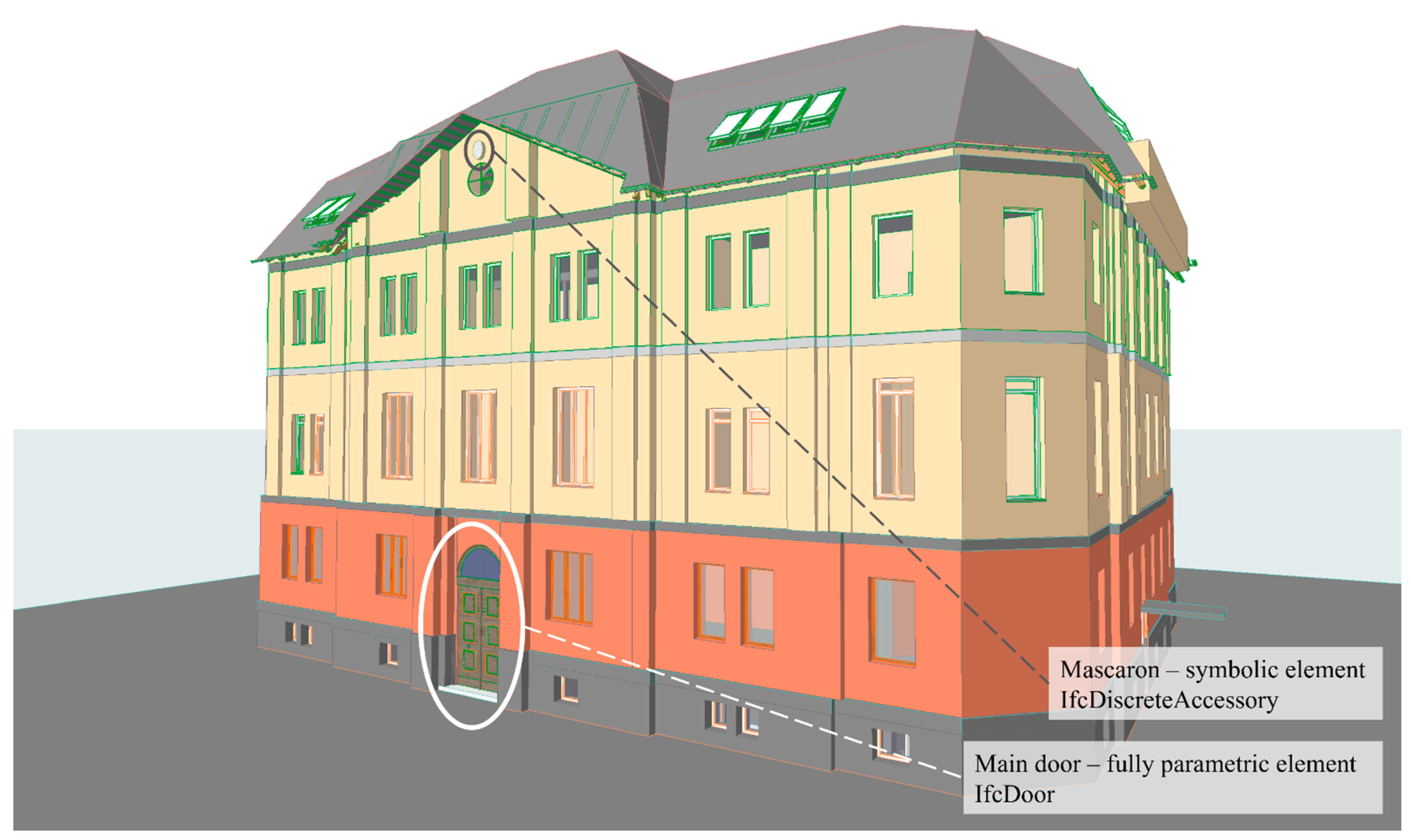

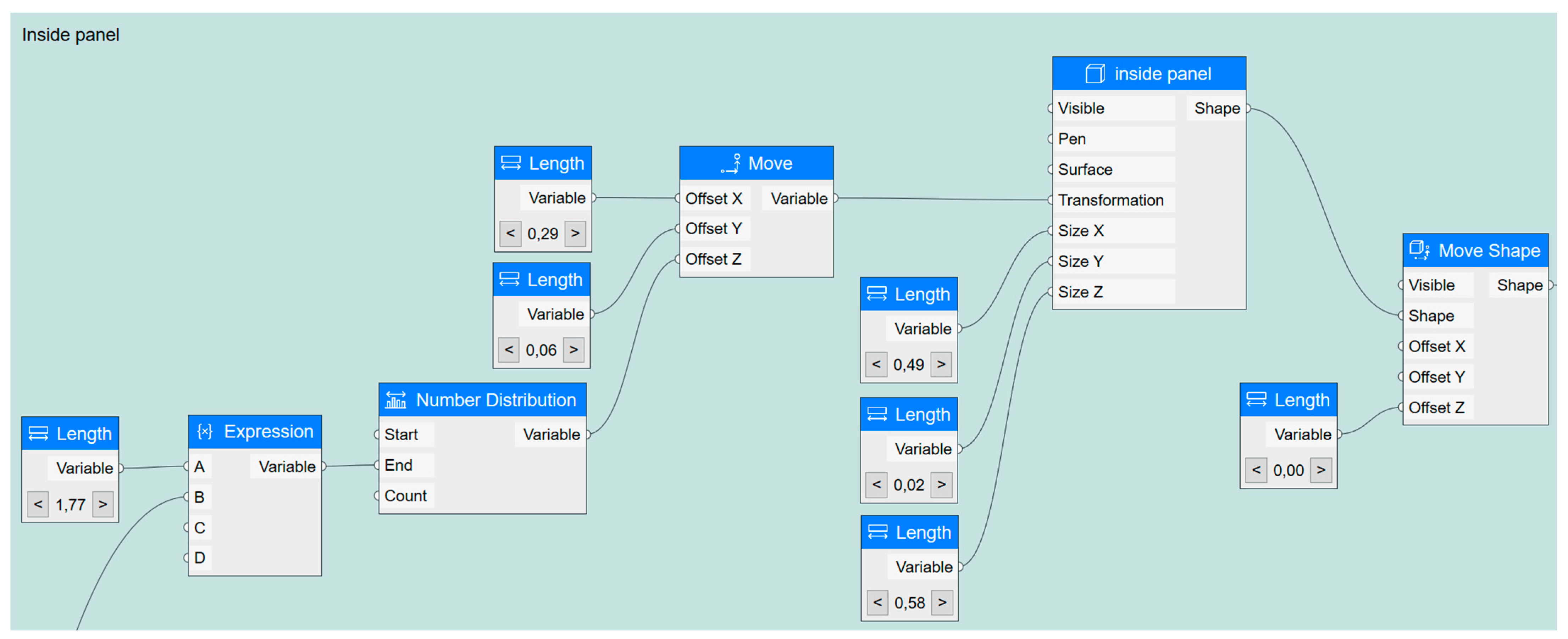

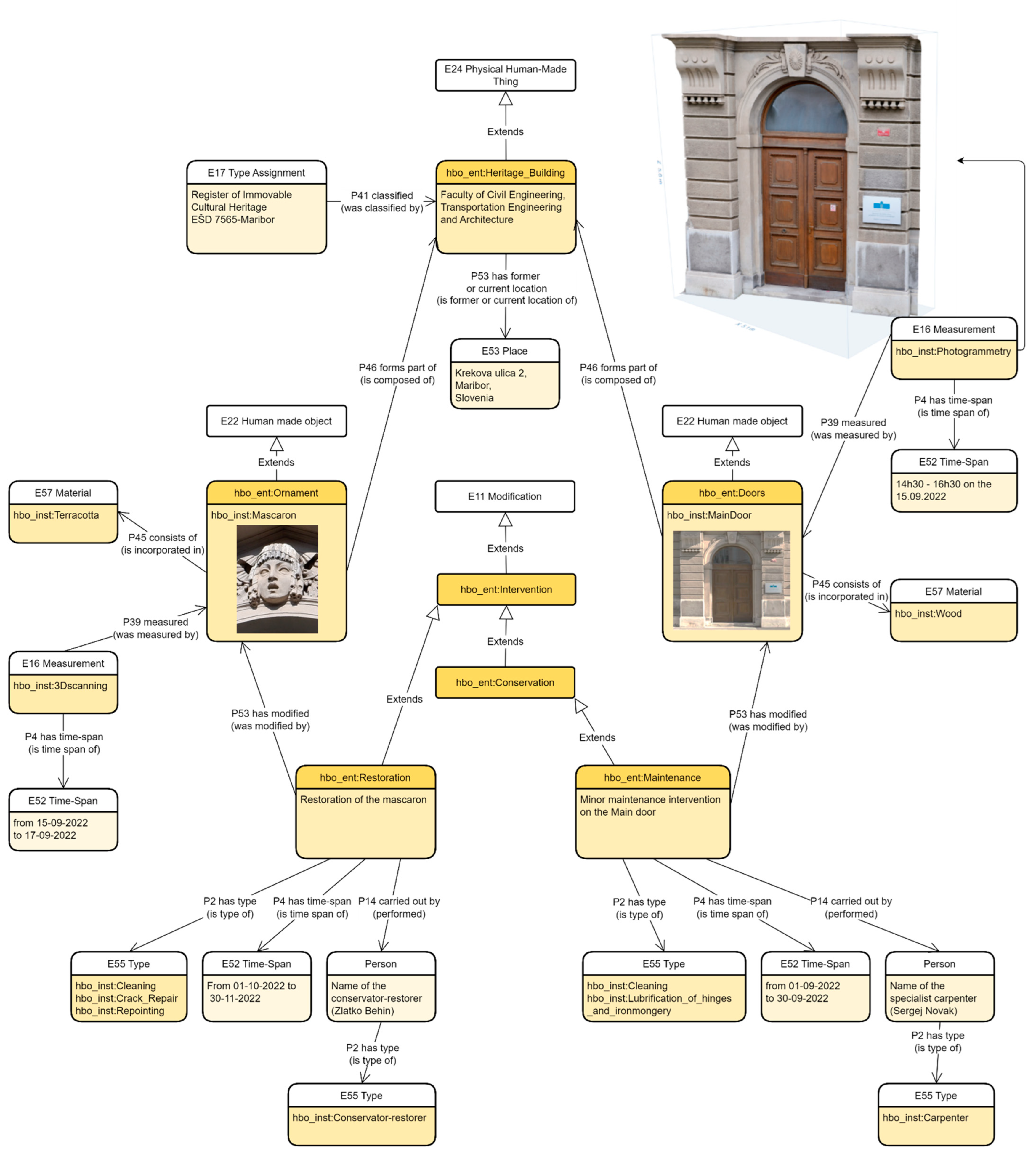
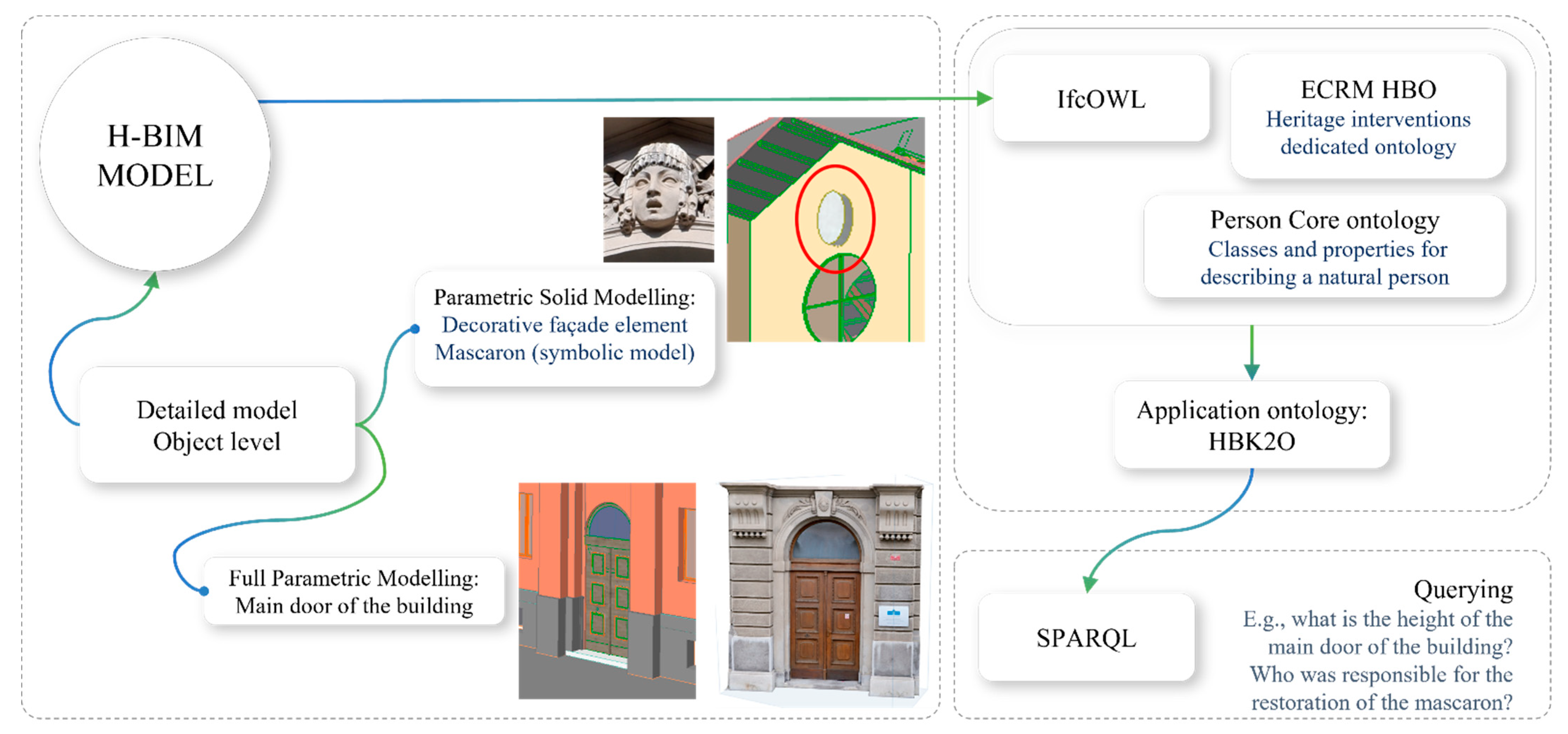
| Intervention | Definition |
|---|---|
| Conservation | “Conservation means all the processes of looking after a place so as to retain its cultural significance.”; “Conservation may, according to circumstance, include the processes of: retention or reintroduction of a use; retention of associations and meanings; maintenance, preservation, restoration, reconstruction, adaptation and interpretation; and will commonly include a combination of more than one of these.” [12]. |
| Maintenance | “Maintenance means the continuous protective care of a place, and its setting.” [12] |
| Preservation | Preservation means maintaining a place in its existing state and retarding deterioration.” [12]. |
| Restoration | “Restoration means returning a place to a known earlier state by removing accretions or by reassembling existing elements without the introduction of new material.” [12]. |
| Reconstruction | “Reconstruction means returning a place to a known earlier state and is distinguished from restoration by the introduction of new material.” [12]. |
| Adaptation | “Adaptation means changing a place to suit the existing use or a proposed use.”, “Adaptation may involve additions to the place, the introduction of new services, or a new use, or changes to safeguard the place. Adaptation of a place for a new use is often referred to as ‘adaptive re-use’.” [12]. |
| Demolition | Demolition of significant fabric of a place is generally not acceptable. However, in some cases minor demolition may be appropriate as part of conservation. Removed significant fabric should be reinstated when circumstances permit.” [13]. |
| Rehabilitation | “The act or process of making possible a compatible use for a property through repair, alterations, and additions while preserving those portions or features which convey its historical, cultural, or architectural values. Refers also to the activity of returning to good condition deteriorated objects, structures, neighborhoods, or public facilities; and may involve repair, renovation, conversion, expansion, remodeling, or reconstruction.” [13]. |
| Repair | “Repair involves restoration or reconstruction.”: “Repair involving restoration: returning dislodged or relocated fabric to its original location.”, “Repair involving reconstruction: replacing decayed fabric with new fabric.” [13]. |
| Renovation | “Process of making changes to objects, especially buildings or other structures, with the intention of improving their physical condition and returning them to a good state of repair.” [13]. |
| Additions | “Refers to parts added onto an object or structure. In architecture, if a modification does not substantially increase a structure’s volume, use alterations.” [13]. |
| Remodeling | “Changes undertaken with the intention of altering the style or decorative appearance of rooms, spaces, or buildings or other structures, without regard necessarily to historically accurate forms or periods.” [13]. |
| Refurbishment | “The process of updating and redecorating a building or other work, particularly with the implication of making it more energy efficient, eco-friendly, or sustainable. Used primarily in the context of built works.” [13]. |
| Retrofitting | “Adding something new to the original building or structure to improve functionality, structural stability, and/or energy efficiency. These can be new technology, building systems, or equipment. The process of furnishing a building or other object with new parts or equipment not available at the time of its manufacture.” [13]. |
| Classes/Subclasses | ||
|---|---|---|
| hbo_ent:Heritage_Building | ||
| hbo_ent:Intervention | ||
| hbo_ent:Conservation | ||
| hbo_ent:Adaptation | ||
| hbo_ent:Demolition | ||
| hbo_ent:Maintenance | ||
| hbo_ent:Preservation | ||
| hbo_ent:Restoration | ||
| hbo_ent:Rehabilitation | ||
| hbo_ent:Reconstruction | ||
| hbo_ent:Renovation | ||
| hbo_ent:Remodelling | ||
| hbo_ent:Alteration | ||
| hbo_ent:Addition | ||
| hbo_ent:Addition | ||
| hbo_ent:Refurbishment | ||
| hbo_ent:Retrofitting | ||
| hbo_ent:Ornament | ||
| hbo_ent:Doors | ||
| Instances | ||
| hbo_inst:MainDoor; hbo_inst:Mascaron; hbo_inst:Conservator-restorer; hbo_inst:Cleaning; hbo_inst:Crack_Repair; hbo_inst:Repointing; hbo_inst:Lubrification_of_hinges_and_ironmongery; hbo_inst:3Dscanning; hbo_inst:Terracotta; hbo_inst:Wood; hbo_inst:Photogrammetry. | ||
| Characteristics | Score |
|---|---|
| 1. Structural | 3.00 |
| 2. Functional adequacy | 3.80 |
| 3. Transferability | 2.25 |
| 4. Reliability | 5.00 |
| 5. Compatibility | 3.25 |
| 6. Interoperability | 1.50 |
| 7. Maintainability | 2.78 |
| 8. Operability | 2.83 |
| Total ontology quality | 2.93 |
Publisher’s Note: MDPI stays neutral with regard to jurisdictional claims in published maps and institutional affiliations. |
© 2022 by the authors. Licensee MDPI, Basel, Switzerland. This article is an open access article distributed under the terms and conditions of the Creative Commons Attribution (CC BY) license (https://creativecommons.org/licenses/by/4.0/).
Share and Cite
Guerra de Oliveira, S.; Biancardo, S.A.; Tibaut, A. Optimizing H-BIM Workflow for Interventions on Historical Building Elements. Sustainability 2022, 14, 9703. https://doi.org/10.3390/su14159703
Guerra de Oliveira S, Biancardo SA, Tibaut A. Optimizing H-BIM Workflow for Interventions on Historical Building Elements. Sustainability. 2022; 14(15):9703. https://doi.org/10.3390/su14159703
Chicago/Turabian StyleGuerra de Oliveira, Sara, Salvatore Antonio Biancardo, and Andrej Tibaut. 2022. "Optimizing H-BIM Workflow for Interventions on Historical Building Elements" Sustainability 14, no. 15: 9703. https://doi.org/10.3390/su14159703
APA StyleGuerra de Oliveira, S., Biancardo, S. A., & Tibaut, A. (2022). Optimizing H-BIM Workflow for Interventions on Historical Building Elements. Sustainability, 14(15), 9703. https://doi.org/10.3390/su14159703








